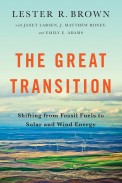Wednesday, September 22, 2010
Lester Brown’s first book was entitled Man, Land, and Food. Published in 1963, it started off as a suggestion from his branch chief, Quentin West, at the U.S. Department of Agriculture (USDA). At the time, they were in the Asia branch of the Economic Research Service. West asked Lester to put together agricultural supply and demand projections for Asia to the end of the century.
Lester was always interested in the big picture, and he realized that unless you know the relative supply and demand relationships in the rest of the world, you wouldn’t know if commodities would flow into or out of the region. To obtain correct projections, he would need to include data for the world. Thus the projections would necessarily have to be world supply and demand projections. Unfortunately because he worked for the Asia branch by rights that was all he was allowed to cover. The USDA was a bureaucracy and everyone had a specialty.
After a few weeks of back and forth discussion on these points, West said he would provide cover for Lester to do the global projections. For the next six months that is what he did while continuing to do his work as a regional economist.
By the end of 1962 he finished the study, and entitled it Man, Land, and Food: Looking Ahead at World Food Needs. He’d also included a population dimension. The trick now was to get it published. In entered the bureaucracy. The regional director said he couldn’t send it for publication because the other branches—Latin America, Europe, Africa, etc.—didn’t know the study existed and since Lester was doing their projections, they wouldn’t agree to it. (Turf wars!)
But the regional director knew it was a good study. So when he went on vacation a couple months later, he appointed West as acting regional director, letting him know that if he wanted to send the study for publication, it would be his call. And that’s what West did. The cat, in essence, was out of the bag and conflict came in its wake, but it didn’t stop the presses.
However, despite the fact that the book was getting printed, Lester knew it could still get deep-sixed, because it dealt with population and at the time the U.S. government did not touch population issues. He needed a strategy to keep it from being buried, so he turned to the media. Getting a good article published about the report would keep it alive.
So, before the book was off the press, Lester contacted the U.S. News and World Report, thinking the magazine might be a good fit because it frequently used graphics and data in its articles. He met with one of their agricultural reporters and went over a copy of the study, even giving a precious copy to the reporter. In the age before the copy machine or PDFs, it was a carbon copy. However, the reporter didn’t seem too engaged with the ideas.
To Lester’s surprise, a couple weeks later the reporter came back with his senior editor. They called the book a pioneering work, the first time anyone had tried to project world agriculture—land, water, food, fertilizer, and population—to the end of the century. This all happened in September/October of 1963. The article was slated for release in the last issue of November 1963.
And here history intervened. As many may remember, President John F. Kennedy was assassinated on November 22, 1963. The media focused their attention on the assassination, the appointment of the Warren Commission, Vice President Lyndon Johnson being sworn in as President, which Cabinet members would stay, which would leave, policy changes, etc. And the article on Lester’s book seemed to have been forgotten.
When Christmas came along, Lester, his wife Shirley Ann, and their three-year-old son Brian, went as they always did to his in-law’s Wyoming ranch. They took the train. A week later, Lester returned to work while his wife and son stayed in Wyoming for another week. At the newsstand in the Cheyenne train station he picked up the January 6, 1964 issue of U.S. News & World Report. It carried two cover stories. One was on the great train robbery in London where $14 million had been stolen. The second was “The Changing Food World Prospect,” the four-page article on Lester’s book. The article made news around the world. 
And suddenly a rather obscure economic analyst came to the attention of the Secretary of Agriculture, Orville Freeman. Freeman and his staff wondered who this Lester Brown was and who’d authorized the study. As Lester said, “It was never budgeted for. After I finished it, it existed, but it didn’t exist, because it was never on any schedule or any plan of work. It was sort of in between worlds. I was entirely outside the realm of being a proper bureaucrat, doing an unauthorized study at the global level, when my responsibility was only in Asia.”
The end result was that Secretary Freeman appointed him as his Foreign Policy Advisor, which eventually became an appointment as Administrator of the International Agricultural Development Service. Lester had always had the goal of understanding world agriculture and all that went with it. Man, Land, and Food was one of the first major manifestations of this.
And as his latest book attests, Plan B 4.0: Mobilizing to Save Civilization, he is still looking at the big picture.
Sincerely,
Reah Janise Kauffman
Vice President
Page 1 of 1 pages





